A Requirement Constraint's Impact on Project Development Life Cycle
VerifiedAdded on 2023/05/31
|10
|2313
|133
Report
AI Summary
This report examines the impact of requirement constraints on project development lifecycles, comparing the waterfall and agile methodologies. It identifies key constraints within each approach, such as scope, cost, and schedule, and analyzes how these constraints affect project outcomes. The report highlights that the waterfall model struggles with change management and client feedback, impacting project scope and quality, while the agile methodology faces challenges related to scheduling and managerial control, potentially leading to compromised project scopes. The findings emphasize the importance of understanding and mitigating these constraints to ensure successful project delivery and sustainability, with a focus on how overscheduling and cost overruns can have cascading effects on project stakeholders and overall project success. The report also references real-world examples to illustrate the significant consequences of unmanaged project constraints.
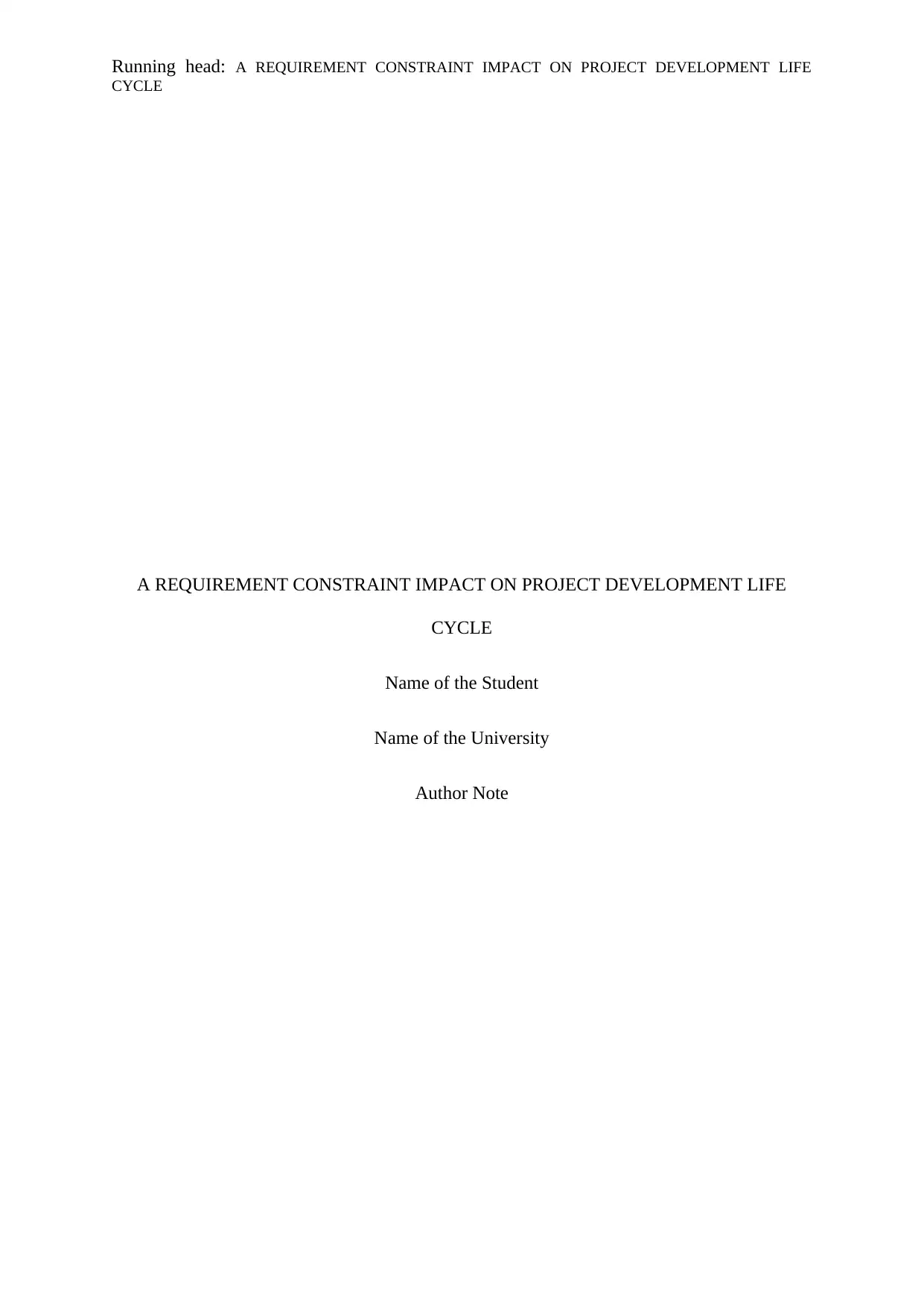
Running head: A REQUIREMENT CONSTRAINT IMPACT ON PROJECT DEVELOPMENT LIFE
CYCLE
A REQUIREMENT CONSTRAINT IMPACT ON PROJECT DEVELOPMENT LIFE
CYCLE
Name of the Student
Name of the University
Author Note
CYCLE
A REQUIREMENT CONSTRAINT IMPACT ON PROJECT DEVELOPMENT LIFE
CYCLE
Name of the Student
Name of the University
Author Note
Paraphrase This Document
Need a fresh take? Get an instant paraphrase of this document with our AI Paraphraser
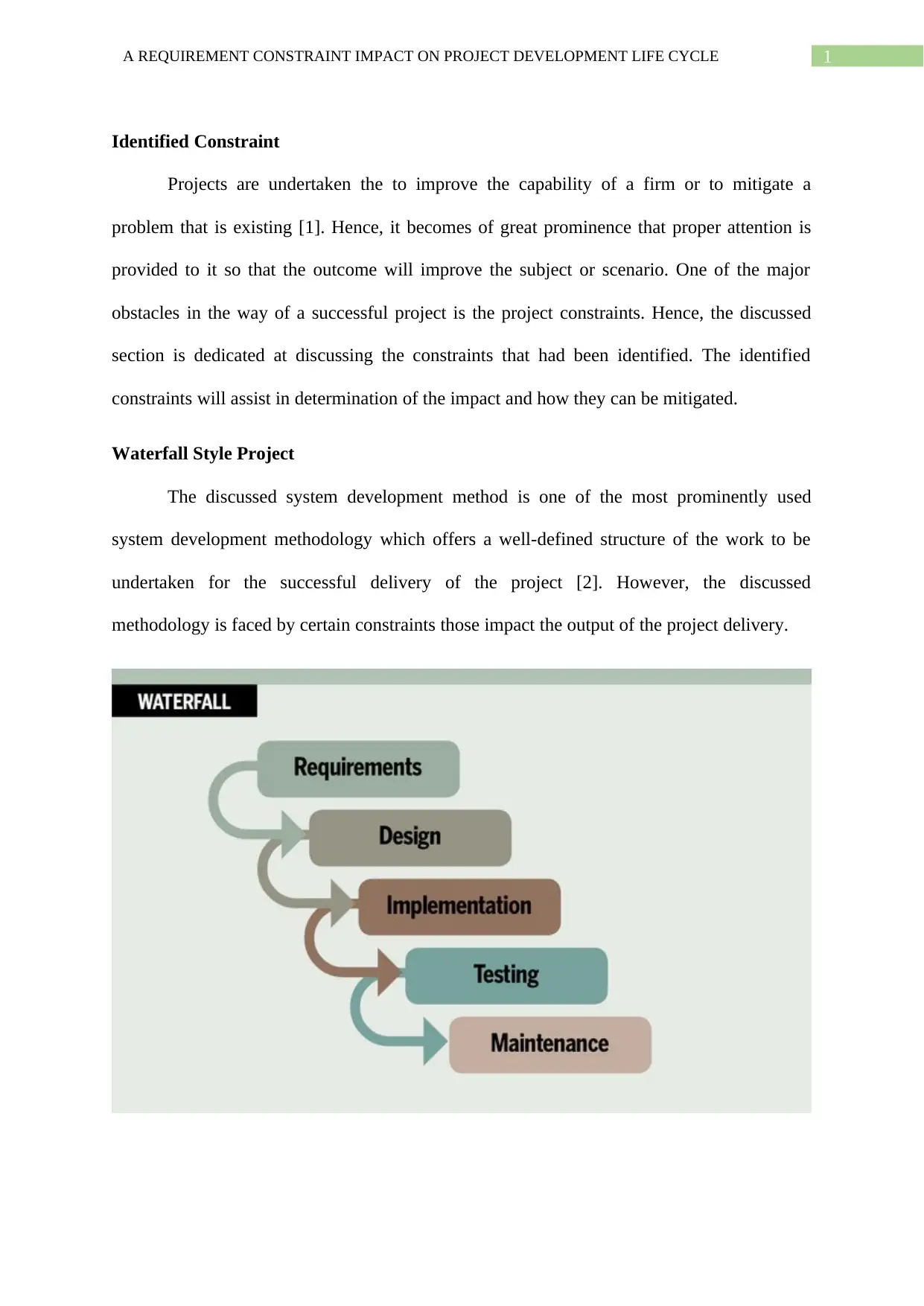
1A REQUIREMENT CONSTRAINT IMPACT ON PROJECT DEVELOPMENT LIFE CYCLE
Identified Constraint
Projects are undertaken the to improve the capability of a firm or to mitigate a
problem that is existing [1]. Hence, it becomes of great prominence that proper attention is
provided to it so that the outcome will improve the subject or scenario. One of the major
obstacles in the way of a successful project is the project constraints. Hence, the discussed
section is dedicated at discussing the constraints that had been identified. The identified
constraints will assist in determination of the impact and how they can be mitigated.
Waterfall Style Project
The discussed system development method is one of the most prominently used
system development methodology which offers a well-defined structure of the work to be
undertaken for the successful delivery of the project [2]. However, the discussed
methodology is faced by certain constraints those impact the output of the project delivery.
Identified Constraint
Projects are undertaken the to improve the capability of a firm or to mitigate a
problem that is existing [1]. Hence, it becomes of great prominence that proper attention is
provided to it so that the outcome will improve the subject or scenario. One of the major
obstacles in the way of a successful project is the project constraints. Hence, the discussed
section is dedicated at discussing the constraints that had been identified. The identified
constraints will assist in determination of the impact and how they can be mitigated.
Waterfall Style Project
The discussed system development method is one of the most prominently used
system development methodology which offers a well-defined structure of the work to be
undertaken for the successful delivery of the project [2]. However, the discussed
methodology is faced by certain constraints those impact the output of the project delivery.
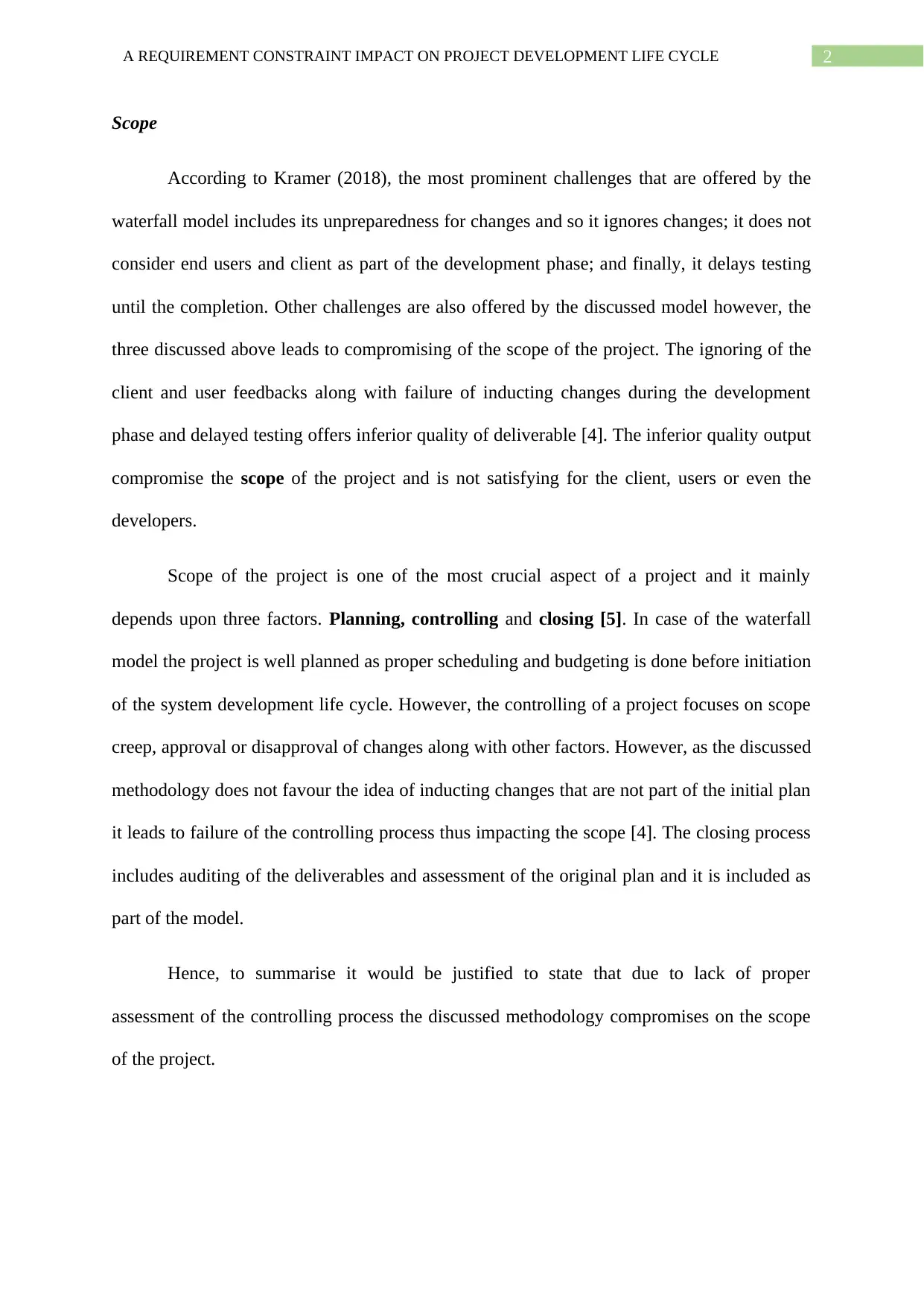
2A REQUIREMENT CONSTRAINT IMPACT ON PROJECT DEVELOPMENT LIFE CYCLE
Scope
According to Kramer (2018), the most prominent challenges that are offered by the
waterfall model includes its unpreparedness for changes and so it ignores changes; it does not
consider end users and client as part of the development phase; and finally, it delays testing
until the completion. Other challenges are also offered by the discussed model however, the
three discussed above leads to compromising of the scope of the project. The ignoring of the
client and user feedbacks along with failure of inducting changes during the development
phase and delayed testing offers inferior quality of deliverable [4]. The inferior quality output
compromise the scope of the project and is not satisfying for the client, users or even the
developers.
Scope of the project is one of the most crucial aspect of a project and it mainly
depends upon three factors. Planning, controlling and closing [5]. In case of the waterfall
model the project is well planned as proper scheduling and budgeting is done before initiation
of the system development life cycle. However, the controlling of a project focuses on scope
creep, approval or disapproval of changes along with other factors. However, as the discussed
methodology does not favour the idea of inducting changes that are not part of the initial plan
it leads to failure of the controlling process thus impacting the scope [4]. The closing process
includes auditing of the deliverables and assessment of the original plan and it is included as
part of the model.
Hence, to summarise it would be justified to state that due to lack of proper
assessment of the controlling process the discussed methodology compromises on the scope
of the project.
Scope
According to Kramer (2018), the most prominent challenges that are offered by the
waterfall model includes its unpreparedness for changes and so it ignores changes; it does not
consider end users and client as part of the development phase; and finally, it delays testing
until the completion. Other challenges are also offered by the discussed model however, the
three discussed above leads to compromising of the scope of the project. The ignoring of the
client and user feedbacks along with failure of inducting changes during the development
phase and delayed testing offers inferior quality of deliverable [4]. The inferior quality output
compromise the scope of the project and is not satisfying for the client, users or even the
developers.
Scope of the project is one of the most crucial aspect of a project and it mainly
depends upon three factors. Planning, controlling and closing [5]. In case of the waterfall
model the project is well planned as proper scheduling and budgeting is done before initiation
of the system development life cycle. However, the controlling of a project focuses on scope
creep, approval or disapproval of changes along with other factors. However, as the discussed
methodology does not favour the idea of inducting changes that are not part of the initial plan
it leads to failure of the controlling process thus impacting the scope [4]. The closing process
includes auditing of the deliverables and assessment of the original plan and it is included as
part of the model.
Hence, to summarise it would be justified to state that due to lack of proper
assessment of the controlling process the discussed methodology compromises on the scope
of the project.
⊘ This is a preview!⊘
Do you want full access?
Subscribe today to unlock all pages.

Trusted by 1+ million students worldwide
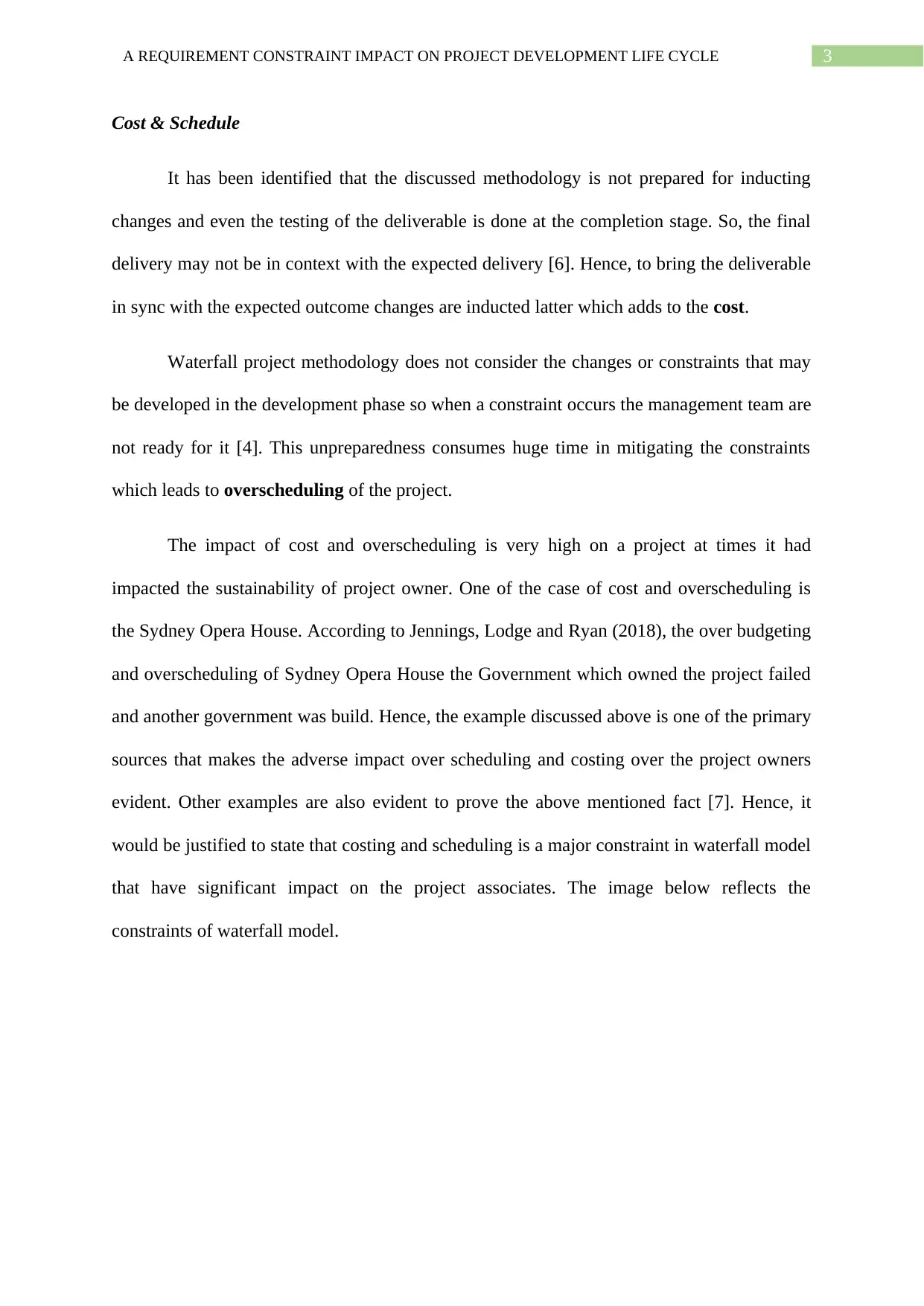
3A REQUIREMENT CONSTRAINT IMPACT ON PROJECT DEVELOPMENT LIFE CYCLE
Cost & Schedule
It has been identified that the discussed methodology is not prepared for inducting
changes and even the testing of the deliverable is done at the completion stage. So, the final
delivery may not be in context with the expected delivery [6]. Hence, to bring the deliverable
in sync with the expected outcome changes are inducted latter which adds to the cost.
Waterfall project methodology does not consider the changes or constraints that may
be developed in the development phase so when a constraint occurs the management team are
not ready for it [4]. This unpreparedness consumes huge time in mitigating the constraints
which leads to overscheduling of the project.
The impact of cost and overscheduling is very high on a project at times it had
impacted the sustainability of project owner. One of the case of cost and overscheduling is
the Sydney Opera House. According to Jennings, Lodge and Ryan (2018), the over budgeting
and overscheduling of Sydney Opera House the Government which owned the project failed
and another government was build. Hence, the example discussed above is one of the primary
sources that makes the adverse impact over scheduling and costing over the project owners
evident. Other examples are also evident to prove the above mentioned fact [7]. Hence, it
would be justified to state that costing and scheduling is a major constraint in waterfall model
that have significant impact on the project associates. The image below reflects the
constraints of waterfall model.
Cost & Schedule
It has been identified that the discussed methodology is not prepared for inducting
changes and even the testing of the deliverable is done at the completion stage. So, the final
delivery may not be in context with the expected delivery [6]. Hence, to bring the deliverable
in sync with the expected outcome changes are inducted latter which adds to the cost.
Waterfall project methodology does not consider the changes or constraints that may
be developed in the development phase so when a constraint occurs the management team are
not ready for it [4]. This unpreparedness consumes huge time in mitigating the constraints
which leads to overscheduling of the project.
The impact of cost and overscheduling is very high on a project at times it had
impacted the sustainability of project owner. One of the case of cost and overscheduling is
the Sydney Opera House. According to Jennings, Lodge and Ryan (2018), the over budgeting
and overscheduling of Sydney Opera House the Government which owned the project failed
and another government was build. Hence, the example discussed above is one of the primary
sources that makes the adverse impact over scheduling and costing over the project owners
evident. Other examples are also evident to prove the above mentioned fact [7]. Hence, it
would be justified to state that costing and scheduling is a major constraint in waterfall model
that have significant impact on the project associates. The image below reflects the
constraints of waterfall model.
Paraphrase This Document
Need a fresh take? Get an instant paraphrase of this document with our AI Paraphraser
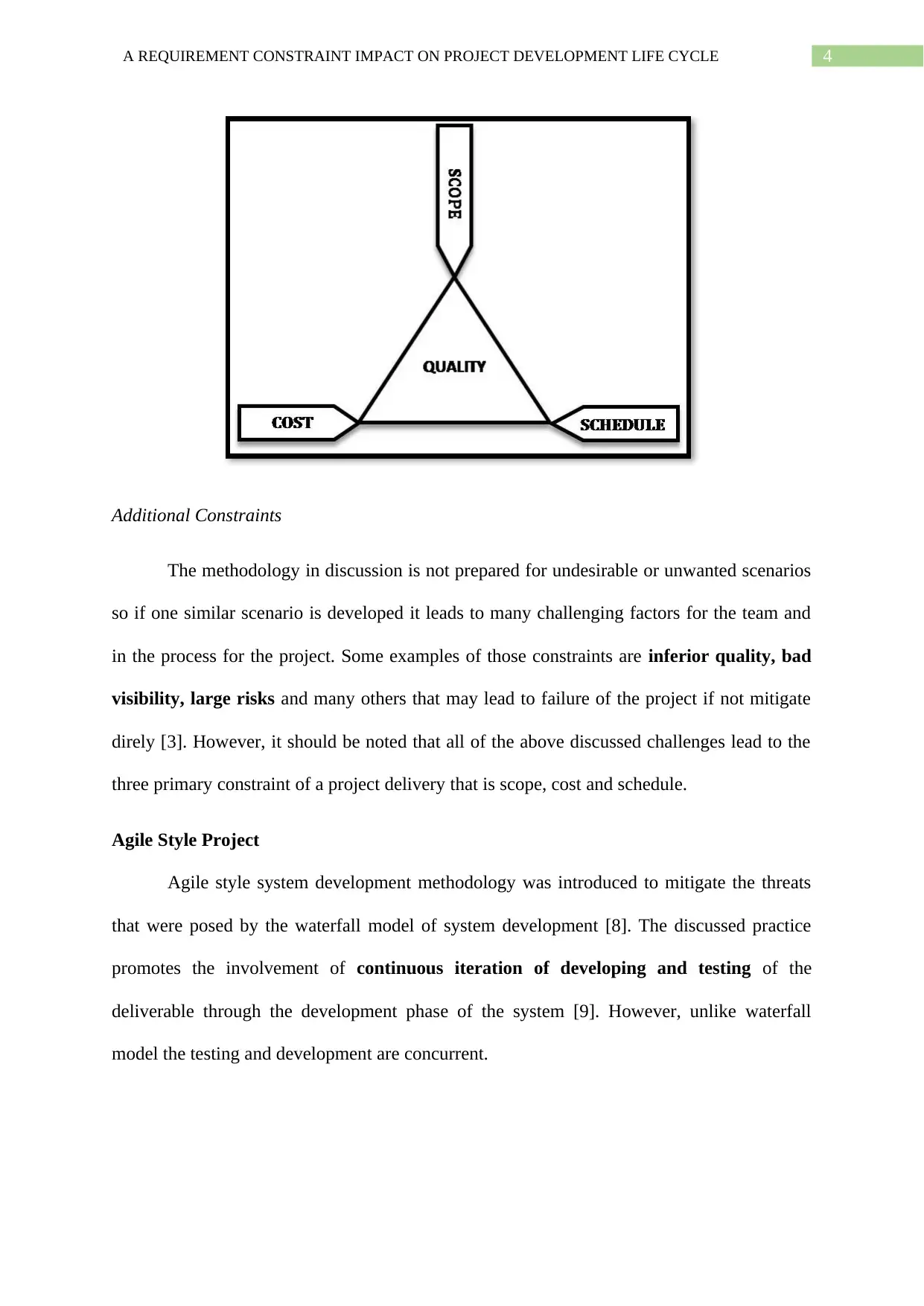
4A REQUIREMENT CONSTRAINT IMPACT ON PROJECT DEVELOPMENT LIFE CYCLE
Additional Constraints
The methodology in discussion is not prepared for undesirable or unwanted scenarios
so if one similar scenario is developed it leads to many challenging factors for the team and
in the process for the project. Some examples of those constraints are inferior quality, bad
visibility, large risks and many others that may lead to failure of the project if not mitigate
direly [3]. However, it should be noted that all of the above discussed challenges lead to the
three primary constraint of a project delivery that is scope, cost and schedule.
Agile Style Project
Agile style system development methodology was introduced to mitigate the threats
that were posed by the waterfall model of system development [8]. The discussed practice
promotes the involvement of continuous iteration of developing and testing of the
deliverable through the development phase of the system [9]. However, unlike waterfall
model the testing and development are concurrent.
Additional Constraints
The methodology in discussion is not prepared for undesirable or unwanted scenarios
so if one similar scenario is developed it leads to many challenging factors for the team and
in the process for the project. Some examples of those constraints are inferior quality, bad
visibility, large risks and many others that may lead to failure of the project if not mitigate
direly [3]. However, it should be noted that all of the above discussed challenges lead to the
three primary constraint of a project delivery that is scope, cost and schedule.
Agile Style Project
Agile style system development methodology was introduced to mitigate the threats
that were posed by the waterfall model of system development [8]. The discussed practice
promotes the involvement of continuous iteration of developing and testing of the
deliverable through the development phase of the system [9]. However, unlike waterfall
model the testing and development are concurrent.
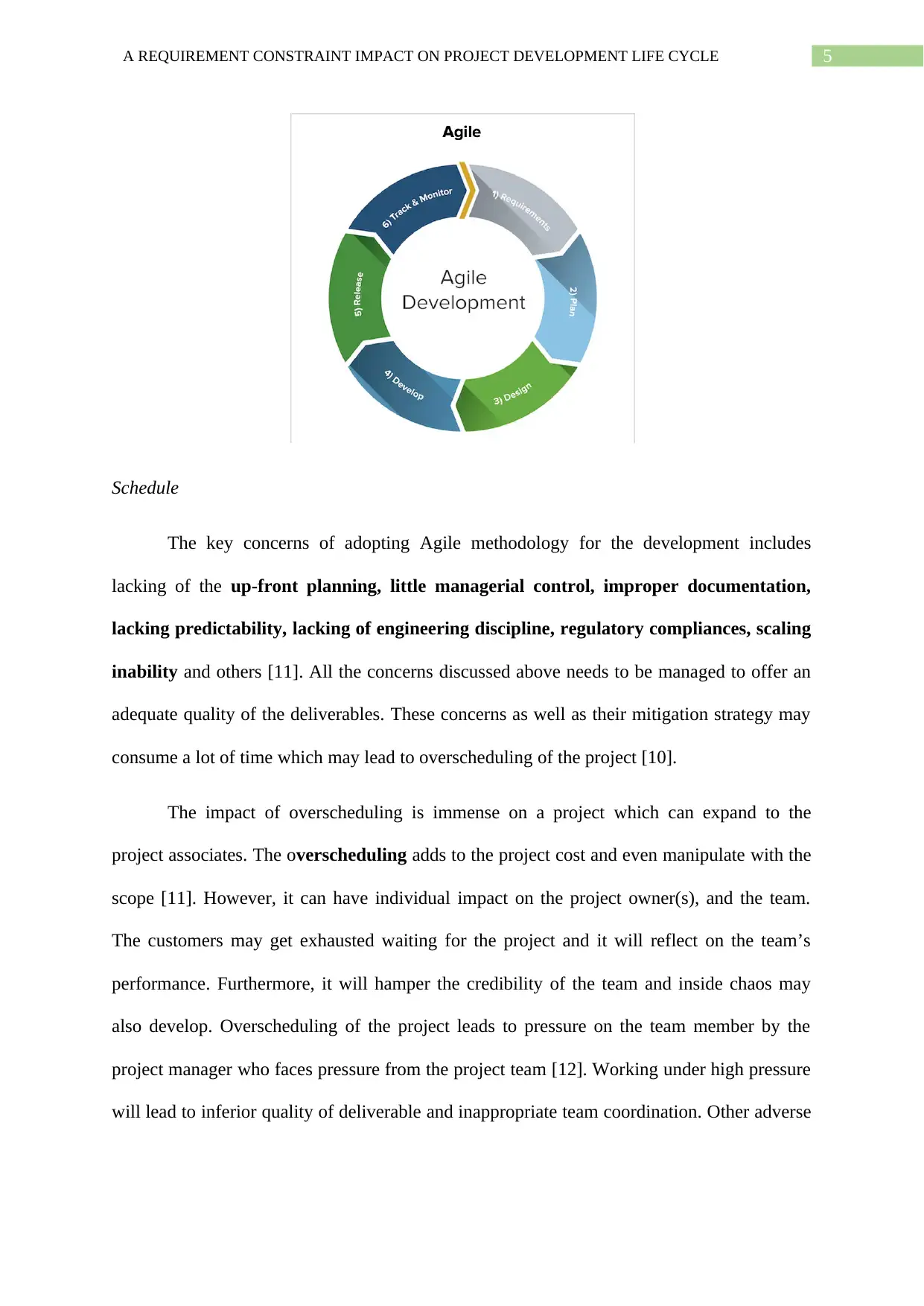
5A REQUIREMENT CONSTRAINT IMPACT ON PROJECT DEVELOPMENT LIFE CYCLE
Schedule
The key concerns of adopting Agile methodology for the development includes
lacking of the up-front planning, little managerial control, improper documentation,
lacking predictability, lacking of engineering discipline, regulatory compliances, scaling
inability and others [11]. All the concerns discussed above needs to be managed to offer an
adequate quality of the deliverables. These concerns as well as their mitigation strategy may
consume a lot of time which may lead to overscheduling of the project [10].
The impact of overscheduling is immense on a project which can expand to the
project associates. The overscheduling adds to the project cost and even manipulate with the
scope [11]. However, it can have individual impact on the project owner(s), and the team.
The customers may get exhausted waiting for the project and it will reflect on the team’s
performance. Furthermore, it will hamper the credibility of the team and inside chaos may
also develop. Overscheduling of the project leads to pressure on the team member by the
project manager who faces pressure from the project team [12]. Working under high pressure
will lead to inferior quality of deliverable and inappropriate team coordination. Other adverse
Schedule
The key concerns of adopting Agile methodology for the development includes
lacking of the up-front planning, little managerial control, improper documentation,
lacking predictability, lacking of engineering discipline, regulatory compliances, scaling
inability and others [11]. All the concerns discussed above needs to be managed to offer an
adequate quality of the deliverables. These concerns as well as their mitigation strategy may
consume a lot of time which may lead to overscheduling of the project [10].
The impact of overscheduling is immense on a project which can expand to the
project associates. The overscheduling adds to the project cost and even manipulate with the
scope [11]. However, it can have individual impact on the project owner(s), and the team.
The customers may get exhausted waiting for the project and it will reflect on the team’s
performance. Furthermore, it will hamper the credibility of the team and inside chaos may
also develop. Overscheduling of the project leads to pressure on the team member by the
project manager who faces pressure from the project team [12]. Working under high pressure
will lead to inferior quality of deliverable and inappropriate team coordination. Other adverse
⊘ This is a preview!⊘
Do you want full access?
Subscribe today to unlock all pages.

Trusted by 1+ million students worldwide
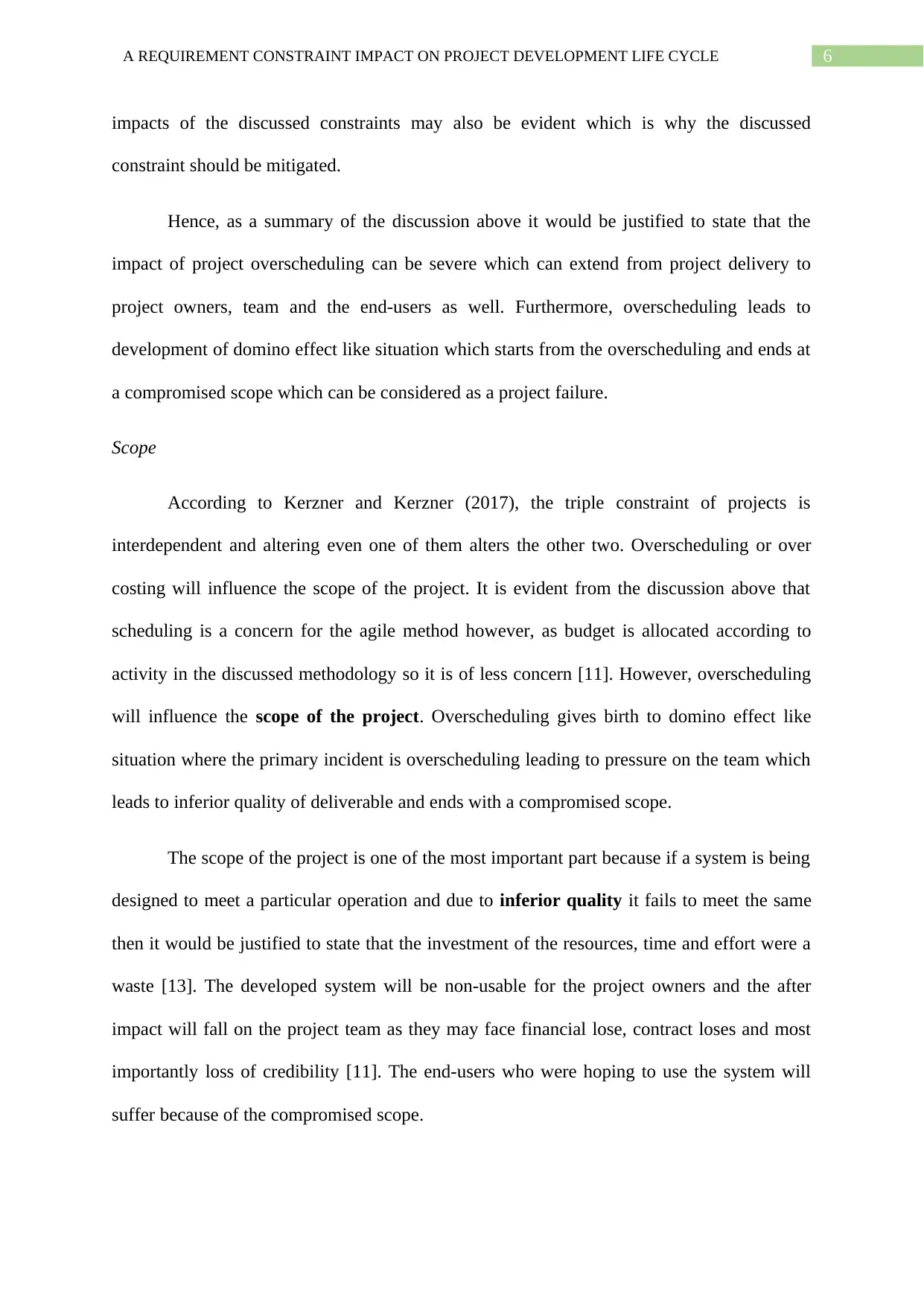
6A REQUIREMENT CONSTRAINT IMPACT ON PROJECT DEVELOPMENT LIFE CYCLE
impacts of the discussed constraints may also be evident which is why the discussed
constraint should be mitigated.
Hence, as a summary of the discussion above it would be justified to state that the
impact of project overscheduling can be severe which can extend from project delivery to
project owners, team and the end-users as well. Furthermore, overscheduling leads to
development of domino effect like situation which starts from the overscheduling and ends at
a compromised scope which can be considered as a project failure.
Scope
According to Kerzner and Kerzner (2017), the triple constraint of projects is
interdependent and altering even one of them alters the other two. Overscheduling or over
costing will influence the scope of the project. It is evident from the discussion above that
scheduling is a concern for the agile method however, as budget is allocated according to
activity in the discussed methodology so it is of less concern [11]. However, overscheduling
will influence the scope of the project. Overscheduling gives birth to domino effect like
situation where the primary incident is overscheduling leading to pressure on the team which
leads to inferior quality of deliverable and ends with a compromised scope.
The scope of the project is one of the most important part because if a system is being
designed to meet a particular operation and due to inferior quality it fails to meet the same
then it would be justified to state that the investment of the resources, time and effort were a
waste [13]. The developed system will be non-usable for the project owners and the after
impact will fall on the project team as they may face financial lose, contract loses and most
importantly loss of credibility [11]. The end-users who were hoping to use the system will
suffer because of the compromised scope.
impacts of the discussed constraints may also be evident which is why the discussed
constraint should be mitigated.
Hence, as a summary of the discussion above it would be justified to state that the
impact of project overscheduling can be severe which can extend from project delivery to
project owners, team and the end-users as well. Furthermore, overscheduling leads to
development of domino effect like situation which starts from the overscheduling and ends at
a compromised scope which can be considered as a project failure.
Scope
According to Kerzner and Kerzner (2017), the triple constraint of projects is
interdependent and altering even one of them alters the other two. Overscheduling or over
costing will influence the scope of the project. It is evident from the discussion above that
scheduling is a concern for the agile method however, as budget is allocated according to
activity in the discussed methodology so it is of less concern [11]. However, overscheduling
will influence the scope of the project. Overscheduling gives birth to domino effect like
situation where the primary incident is overscheduling leading to pressure on the team which
leads to inferior quality of deliverable and ends with a compromised scope.
The scope of the project is one of the most important part because if a system is being
designed to meet a particular operation and due to inferior quality it fails to meet the same
then it would be justified to state that the investment of the resources, time and effort were a
waste [13]. The developed system will be non-usable for the project owners and the after
impact will fall on the project team as they may face financial lose, contract loses and most
importantly loss of credibility [11]. The end-users who were hoping to use the system will
suffer because of the compromised scope.
Paraphrase This Document
Need a fresh take? Get an instant paraphrase of this document with our AI Paraphraser
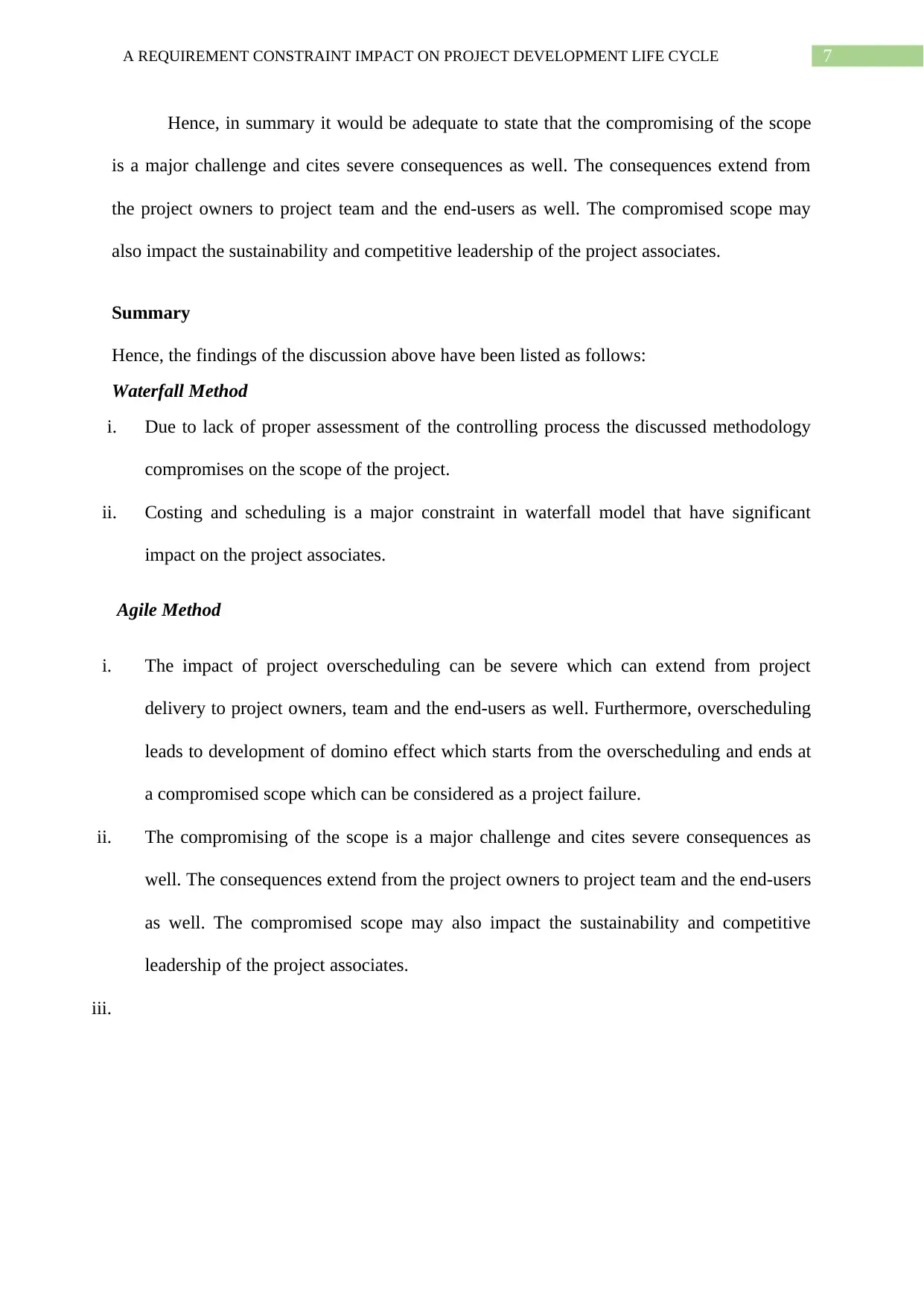
7A REQUIREMENT CONSTRAINT IMPACT ON PROJECT DEVELOPMENT LIFE CYCLE
Hence, in summary it would be adequate to state that the compromising of the scope
is a major challenge and cites severe consequences as well. The consequences extend from
the project owners to project team and the end-users as well. The compromised scope may
also impact the sustainability and competitive leadership of the project associates.
Summary
Hence, the findings of the discussion above have been listed as follows:
Waterfall Method
i. Due to lack of proper assessment of the controlling process the discussed methodology
compromises on the scope of the project.
ii. Costing and scheduling is a major constraint in waterfall model that have significant
impact on the project associates.
Agile Method
i. The impact of project overscheduling can be severe which can extend from project
delivery to project owners, team and the end-users as well. Furthermore, overscheduling
leads to development of domino effect which starts from the overscheduling and ends at
a compromised scope which can be considered as a project failure.
ii. The compromising of the scope is a major challenge and cites severe consequences as
well. The consequences extend from the project owners to project team and the end-users
as well. The compromised scope may also impact the sustainability and competitive
leadership of the project associates.
iii.
Hence, in summary it would be adequate to state that the compromising of the scope
is a major challenge and cites severe consequences as well. The consequences extend from
the project owners to project team and the end-users as well. The compromised scope may
also impact the sustainability and competitive leadership of the project associates.
Summary
Hence, the findings of the discussion above have been listed as follows:
Waterfall Method
i. Due to lack of proper assessment of the controlling process the discussed methodology
compromises on the scope of the project.
ii. Costing and scheduling is a major constraint in waterfall model that have significant
impact on the project associates.
Agile Method
i. The impact of project overscheduling can be severe which can extend from project
delivery to project owners, team and the end-users as well. Furthermore, overscheduling
leads to development of domino effect which starts from the overscheduling and ends at
a compromised scope which can be considered as a project failure.
ii. The compromising of the scope is a major challenge and cites severe consequences as
well. The consequences extend from the project owners to project team and the end-users
as well. The compromised scope may also impact the sustainability and competitive
leadership of the project associates.
iii.
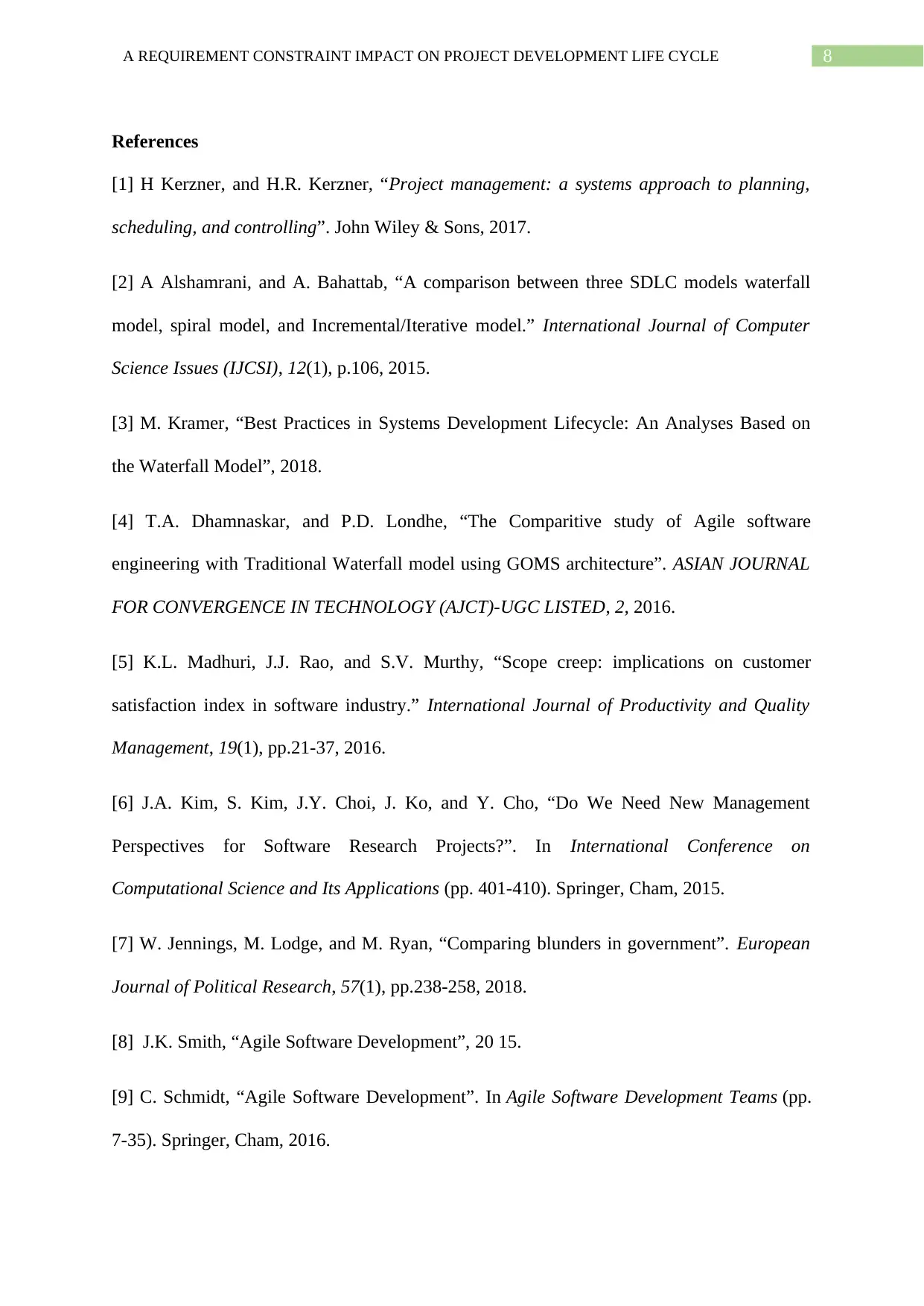
8A REQUIREMENT CONSTRAINT IMPACT ON PROJECT DEVELOPMENT LIFE CYCLE
References
[1] H Kerzner, and H.R. Kerzner, “Project management: a systems approach to planning,
scheduling, and controlling”. John Wiley & Sons, 2017.
[2] A Alshamrani, and A. Bahattab, “A comparison between three SDLC models waterfall
model, spiral model, and Incremental/Iterative model.” International Journal of Computer
Science Issues (IJCSI), 12(1), p.106, 2015.
[3] M. Kramer, “Best Practices in Systems Development Lifecycle: An Analyses Based on
the Waterfall Model”, 2018.
[4] T.A. Dhamnaskar, and P.D. Londhe, “The Comparitive study of Agile software
engineering with Traditional Waterfall model using GOMS architecture”. ASIAN JOURNAL
FOR CONVERGENCE IN TECHNOLOGY (AJCT)-UGC LISTED, 2, 2016.
[5] K.L. Madhuri, J.J. Rao, and S.V. Murthy, “Scope creep: implications on customer
satisfaction index in software industry.” International Journal of Productivity and Quality
Management, 19(1), pp.21-37, 2016.
[6] J.A. Kim, S. Kim, J.Y. Choi, J. Ko, and Y. Cho, “Do We Need New Management
Perspectives for Software Research Projects?”. In International Conference on
Computational Science and Its Applications (pp. 401-410). Springer, Cham, 2015.
[7] W. Jennings, M. Lodge, and M. Ryan, “Comparing blunders in government”. European
Journal of Political Research, 57(1), pp.238-258, 2018.
[8] J.K. Smith, “Agile Software Development”, 20 15.
[9] C. Schmidt, “Agile Software Development”. In Agile Software Development Teams (pp.
7-35). Springer, Cham, 2016.
References
[1] H Kerzner, and H.R. Kerzner, “Project management: a systems approach to planning,
scheduling, and controlling”. John Wiley & Sons, 2017.
[2] A Alshamrani, and A. Bahattab, “A comparison between three SDLC models waterfall
model, spiral model, and Incremental/Iterative model.” International Journal of Computer
Science Issues (IJCSI), 12(1), p.106, 2015.
[3] M. Kramer, “Best Practices in Systems Development Lifecycle: An Analyses Based on
the Waterfall Model”, 2018.
[4] T.A. Dhamnaskar, and P.D. Londhe, “The Comparitive study of Agile software
engineering with Traditional Waterfall model using GOMS architecture”. ASIAN JOURNAL
FOR CONVERGENCE IN TECHNOLOGY (AJCT)-UGC LISTED, 2, 2016.
[5] K.L. Madhuri, J.J. Rao, and S.V. Murthy, “Scope creep: implications on customer
satisfaction index in software industry.” International Journal of Productivity and Quality
Management, 19(1), pp.21-37, 2016.
[6] J.A. Kim, S. Kim, J.Y. Choi, J. Ko, and Y. Cho, “Do We Need New Management
Perspectives for Software Research Projects?”. In International Conference on
Computational Science and Its Applications (pp. 401-410). Springer, Cham, 2015.
[7] W. Jennings, M. Lodge, and M. Ryan, “Comparing blunders in government”. European
Journal of Political Research, 57(1), pp.238-258, 2018.
[8] J.K. Smith, “Agile Software Development”, 20 15.
[9] C. Schmidt, “Agile Software Development”. In Agile Software Development Teams (pp.
7-35). Springer, Cham, 2016.
⊘ This is a preview!⊘
Do you want full access?
Subscribe today to unlock all pages.

Trusted by 1+ million students worldwide
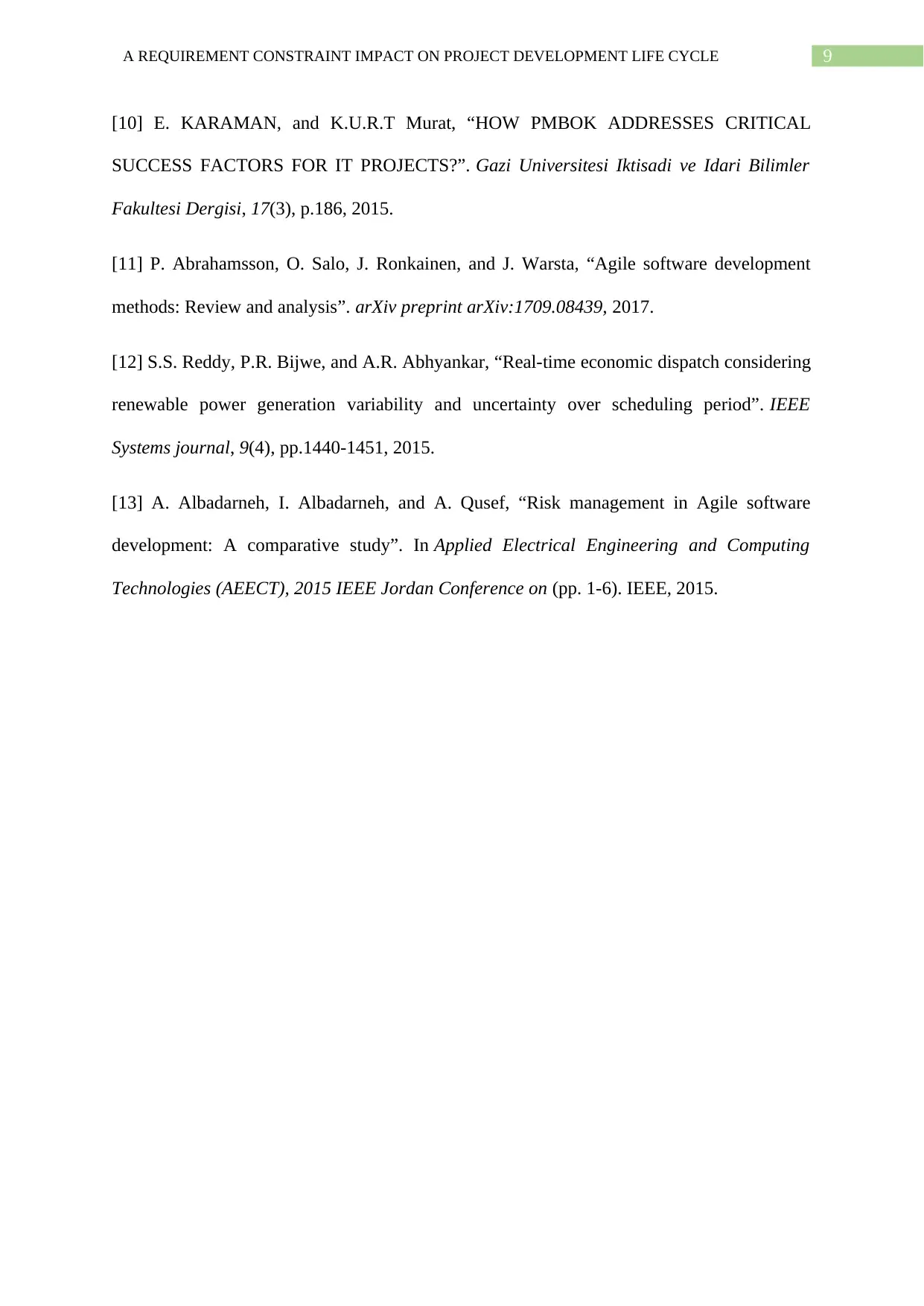
9A REQUIREMENT CONSTRAINT IMPACT ON PROJECT DEVELOPMENT LIFE CYCLE
[10] E. KARAMAN, and K.U.R.T Murat, “HOW PMBOK ADDRESSES CRITICAL
SUCCESS FACTORS FOR IT PROJECTS?”. Gazi Universitesi Iktisadi ve Idari Bilimler
Fakultesi Dergisi, 17(3), p.186, 2015.
[11] P. Abrahamsson, O. Salo, J. Ronkainen, and J. Warsta, “Agile software development
methods: Review and analysis”. arXiv preprint arXiv:1709.08439, 2017.
[12] S.S. Reddy, P.R. Bijwe, and A.R. Abhyankar, “Real-time economic dispatch considering
renewable power generation variability and uncertainty over scheduling period”. IEEE
Systems journal, 9(4), pp.1440-1451, 2015.
[13] A. Albadarneh, I. Albadarneh, and A. Qusef, “Risk management in Agile software
development: A comparative study”. In Applied Electrical Engineering and Computing
Technologies (AEECT), 2015 IEEE Jordan Conference on (pp. 1-6). IEEE, 2015.
[10] E. KARAMAN, and K.U.R.T Murat, “HOW PMBOK ADDRESSES CRITICAL
SUCCESS FACTORS FOR IT PROJECTS?”. Gazi Universitesi Iktisadi ve Idari Bilimler
Fakultesi Dergisi, 17(3), p.186, 2015.
[11] P. Abrahamsson, O. Salo, J. Ronkainen, and J. Warsta, “Agile software development
methods: Review and analysis”. arXiv preprint arXiv:1709.08439, 2017.
[12] S.S. Reddy, P.R. Bijwe, and A.R. Abhyankar, “Real-time economic dispatch considering
renewable power generation variability and uncertainty over scheduling period”. IEEE
Systems journal, 9(4), pp.1440-1451, 2015.
[13] A. Albadarneh, I. Albadarneh, and A. Qusef, “Risk management in Agile software
development: A comparative study”. In Applied Electrical Engineering and Computing
Technologies (AEECT), 2015 IEEE Jordan Conference on (pp. 1-6). IEEE, 2015.
1 out of 10
Related Documents
Your All-in-One AI-Powered Toolkit for Academic Success.
+13062052269
info@desklib.com
Available 24*7 on WhatsApp / Email
![[object Object]](/_next/static/media/star-bottom.7253800d.svg)
Unlock your academic potential
Copyright © 2020–2025 A2Z Services. All Rights Reserved. Developed and managed by ZUCOL.




